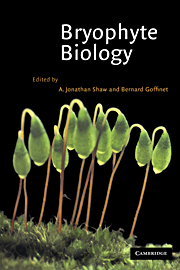Book contents
- Frontmatter
- Contents
- List of contributors
- Preface
- 1 Anatomy, development, and classification of hornworts
- 2 Morphology and classification of the Marchantiophyta
- 3 Morphology and classification of mosses
- 4 Origin and phylogenetic relationships of bryophytes
- 5 Chemical constituents and biochemistry
- 6 Molecular genetic studies of moss species
- 7 Control of morphogenesis in bryophytes
- 8 Physiological ecology
- 9 Mineral nutrition, substratum ecology, and pollution
- 10 Peatlands: ecosystems dominated by bryophytes
- 11 Role of bryophyte-dominated ecosystems in the global carbon budget
- 12 Population ecology, population genetics, and microevolution
- 13 Bryogeography and conservation of bryophytes
- Index
6 - Molecular genetic studies of moss species
Published online by Cambridge University Press: 05 June 2012
- Frontmatter
- Contents
- List of contributors
- Preface
- 1 Anatomy, development, and classification of hornworts
- 2 Morphology and classification of the Marchantiophyta
- 3 Morphology and classification of mosses
- 4 Origin and phylogenetic relationships of bryophytes
- 5 Chemical constituents and biochemistry
- 6 Molecular genetic studies of moss species
- 7 Control of morphogenesis in bryophytes
- 8 Physiological ecology
- 9 Mineral nutrition, substratum ecology, and pollution
- 10 Peatlands: ecosystems dominated by bryophytes
- 11 Role of bryophyte-dominated ecosystems in the global carbon budget
- 12 Population ecology, population genetics, and microevolution
- 13 Bryogeography and conservation of bryophytes
- Index
Summary
Introduction
Research into the classical genetics of mosses is of long standing (see Cove 1983, Reski 1998) but molecular genetic studies of mosses have been slow to gather momentum and are much less extensive than such studies of flowering plants. Nevertheless, mosses present unique opportunities for the study of plant genetics and development, combining simplicity with technical convenience (see reviews by Cove et al. 1997, Reski 1998, Knight 2000). As a result, molecular genetic studies are gaining impetus. DNA, RNA, and proteins are easy to extract particularly from protonemal tissue and genetic transformation is routine for a number of species. The recent establishment that, in Physcomitrella patens, recombination occurs between a homologous sequence in transforming DNA and the corresponding sequence in the genome, allows not only gene knockout but also the prospect of more sophisticated gene manipulation. Furthermore, the characterization of the homologous recombination system has focused attention on mosses and has already resulted in a considerable increase in the numbers of researchers using moss species for molecular genetic studies.
The most extensively studied moss species at the molecular level is Physcomitrella patens. It was Harold Whitehouse, famous for his genetic research on fungi, but a lifelong bryologist, who suggested that P. patens would be suitable for modern genetic research, and the wild-type strain isolated by him from near Cambridge, UK, remains the stock wild type used in most studies of this species.
- Type
- Chapter
- Information
- Bryophyte Biology , pp. 182 - 198Publisher: Cambridge University PressPrint publication year: 2000
- 1
- Cited by



